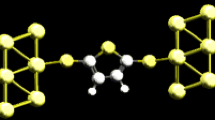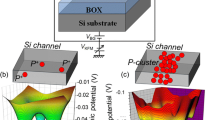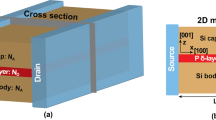Abstract
The quantum conductance properties of pyrene molecule and its silicone-doped variant between semi- infinite aluminum nano-chains were investigated using the density functional theory combined with the nonequilibrium Green function method. Electronic transport computations were carried out in the bias voltage ranging from 0.0 to +2.0 V divided by 0.1 V step-sized intervals and under the gate potentials including \(-\)3.0, 0.0 and +3.0 V. The current-bias curves at the considered bias and gates potential showed regions with negative differential resistance (NDR). The effects of the variations of the gates on the NDR characteristics, including the number of NDR peaks, bias range and current maxima’s at the peak, have been discussed and the potential applicability of the devices as nano-switches and multi-nano-switches have been highlighted. The transmission spectrum along with the density of states (DOS) and projected DOS (PDOS) has also been presented and transmission variations have been addressed in terms of the DOS and PDOS variations. Quantum conductance at zero bias versus the gate potential has also been presented.









Similar content being viewed by others
References
Nitzan, A.: Electron transmission through molecules and molecular interfaces. Ann. Rev. Phys. Chem. 52, 681 (2001)
Heath, J.R., Ratner, M.A.: Molecular electronics. Phys. Today 56, 43–49 (2003)
Joachim, C., Ratner, M.A.: Molecular electronics: some views on transport junctions and beyond. Proc. Natl. Acad. Sci. USA 102, 8801–8808 (2005)
Tour, J.M.: Molecular Electronics: Commercial Insights, Chemistry, Devices, Architecture and Programming. World Scientific, New Jersey (2003)
Joachim, C., Gimzewski, J.K., Aviram, A.: Electronics using hybrid-molecular and mono-molecular devices. Nature 408, 541–548 (2000)
Darancet, P., Widawsky, J., Choi, H., Venkataraman, L., Neaton, J.: Quantitative current–voltage characteristics in molecular junctions from first principles. Nano Lett. 12, 6250–6254 (2012)
Paulsson, M., Zahid, F., Datta, S.: Resistance of a molecule. In: Brenner, D., Lyshevski, S., Iafrate, G. (eds.) Engineering and Technology Handbook, p. 1080. CRC Press, Boca Raton (2007)
Haug, H., Jauho, A.P.: Quantum Kinetics in Transport and Optics of Semiconductors. Springer, Berlin (2007)
Caroli, C., Combescot, R., Nozieres, P., Saint-James, D.: Direct calculation of the tunneling current. J. Phys. C: Solid State Phys. 4, 916–929 (1971)
Schwinger, J.: Brownian motion of a quantum oscillator. J. Math. Phys. 2, 407–432 (1961)
Keldysh, L.V.: Diagram Technique for Nonequilibrium Processes. J. Phys. JETP 20, 1018 (1965)
Reddy, D., Register, L.F., Carpenter, G.D., Banerjee, S.K.: Graphene field-effect transistors. J. Phys. D: Appl. Phys. 44, 313001 (2011)
Wang, H., Chan, G.K.L.: Self-interaction and molecular Coulomb blockade transport in ab initio Hartree–Fock theory. Phys. Rev. B 76, 193310 (2007)
Rocha, A.R., Garcia-Suarez, V.M., Bailey, S., Lambert, C., Ferrer, J., Sanvito, S.: Spin and molecular electronics in atomically generated orbital landscapes. Phys. Rev. B 73, 085414 (2006)
Bilic, A., Sanvito, S.: Tailoring highly conductive graphene nanoribbons from small polycyclic aromatic hydrocarbons: a computational study. J. Phys.: Condens. Matter 25, 275301 (2013)
Wu, J., Pisula, W., Mullen, K.: Graphene molecules as potential material for electronics. Chem. Rev. 107, 718–747 (2007)
Bilic, A., Gale, J.D., Sanvito, S.: From fused aromatics to graphene-like nanoribbons: the effects of multiple terminal groups, length and symmetric pathways on charge transport. Phys. Rev. B 84, 205436 (2011)
Wang, X., Sun, G., Routh, P., Kim, D.H., Chen, P.: Heteroatom-doped graphene materials: syntheses, properties and applications. Chem. Soc. Rev. 43, 7067–7098 (2014)
Hasmy, A., Perez-Jimenez, A.J., Palacios, J.J., Garcia-Mochales, P., Costa-Kramer, J.L., Diaz, M., Medina, E., Serena, P.A.: Ballistic resistivity in aluminum nanocontacts. Phys. Rev. B 72, 245405 (2005)
Scheer, E., Agrait, N., Cuevas, J.C., Yeyati, A.L., Ludoph, B., Martin-Rodero, A., Rubio, G., Bollinger, R., Ruitenbeek, JMv, Urbina, C.: The signature of chemical valence in the electrical conduction through a single-atom contact. Nature 394, 154–157 (1998)
Schee, E., Joyez, P., Esteve, D., Urbina, C., Devoret, M.H.: Conduction channel transmissions of atomic-size aluminum contacts. Phys. Rev. Lett. 78, 3535–3538 (1997)
Simbeck, A.J., Lanzillo, N., Kharche, N., Verstraete, M.J., Nayak, S.K.: Aluminum conducts better than copper at the atomic scale: a first-principles study of metallic atomic wires. ACS Nano 6, 10449–10455 (2012)
Mahmoud, A., Lugli, P.: Study on molecular devices with negative differential resistance. Appl. Phys. Lett 103, 033506 (2013)
Chen, S.L., Griffin, P.B., Plummer, J.D.: Negative differential resistance circuit design and memory applications. IEEE Trans. Electron Devices 56, 634–640 (2009)
Saha, K.K., Nikolic, B.K.: Negative differential resistance in graphene-nanoribbon carbon-nanotube crossbars: a first-principles multiterminal quantum transport study. J. Comput. Electron. 12, 542–552 (2013)
Kondo, H., Kino, H., Nara, J., Ozaki, T., Ohno, T.: Contact-structure dependence of transport properties of a single organic molecule between Au electrodes. Phys. Rev. B 73, 235323 (2006)
Ozaki, T., Nishio, K., Kino, H.: Efficient implementation of the nonequilibrium Green function method for electronic transport calculations. Phys. Rev. B 81, 035116 (2010)
Chen, G., Mukamel, S.: Reduced electronic density matrices, effective Hamiltonians, and nonlinear susceptibilities of conjugated polyenes. J. Chem. Phys. 103, 9355–9362 (1995)
Landauer, R.: Spatial variation of currents and fields. IBM J. Res. Dev. 1, 233 (1957)
Buttiker, M.: Four-terminal phase-coherent conductance. Phys. Rev. Lett. 57, 1761–1764 (1986)
Taylor, J., Guo, H., Wang, J.: Ab initio modeling of quantum transport properties of molecular electronic devices. Phys. Rev. B. 63, 245407 (2001)
Brandbyge, M., Mozos, J.L., Ordejon, P., Taylor, J., Stokbro, K.: Density-functional method for nonequilibrium electron transport. Phys. Rev. B. 65, 165401 (2002)
URL http://www.openmx-square.org. The code, OPENMX, pseudoatomic basis functions, and pseudo-potentials are available on a web site: http://www.openmx-square.org
Martin, R.M.: Electronic Structure: Basic Theory and Practical Methods. Cambridge University Press, Cambridge (2004)
Perdew, J.P., Burke, K., Ernzerhof, M.: Generalized gradient approximation made simple. Phys. Rev. Lett. 77, 3865 (1996)
Wu, Y., Farmer, D.B., Zhu, W., Han, S.J., Dimitrakopoulos, C.D., Bol, A.A., Avouris, P., Lin, Y.M.: Three-terminal graphene negative differential resistance devices. ACS Nano 6(3), 2610–2616 (2012)
Fano, U.: Effects of configuration interaction on intensities and phase shifts. Phys. Rev. 124, 1866–1878 (1961)
Briet, G., Wigner, E.: Capture of slow neutrons. Phys. Rev. 49, 519–531 (1936)
Sowa-Rykowska, A., Adamowski, J.: Fano resonances in current–voltage characteristics of nanowires with embedded quantum dots. Phys. Rev. B 82, 195311 (2010)
Ke, S.H., Baranger, H.U., Yang, W.: Electron transport through molecules: self-consistent and non-self-consistent approaches. Phys. Rev. B 70, 085410 (2004)
Acknowledgments
This research was supported by a research fund “(No. 217/D/5666)” from Azarbiajan Shahid Madani University.
Author information
Authors and Affiliations
Corresponding author
Rights and permissions
About this article
Cite this article
Rastkar, A., Ghavami, B., Jahanbin, J. et al. The quantum transport of pyrene and its silicon-doped variant: a DFT-NEGF approach. J Comput Electron 14, 619–626 (2015). https://doi.org/10.1007/s10825-015-0692-2
Published:
Issue Date:
DOI: https://doi.org/10.1007/s10825-015-0692-2




